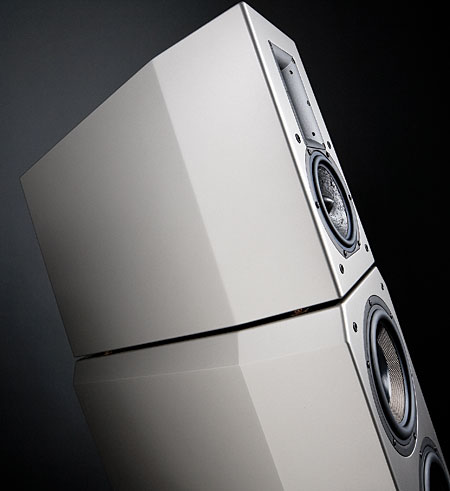| Columns Retired Columns & Blogs |
Aerial Acoustics 20T V2 loudspeaker Page 2
When Kelly returned, this time with David Marshall, the final speaker positions ended up somewhat different from before. Whereas the 20Ts' original positions had been what you might think intuitive for a full-range speaker—well away from room boundaries—the speakers were now very close to the sidewalls and aggressively toed-in to the listening seat. There was also a slight asymmetry to the setup, which Michael explained was to cope with a stronger reflection of treble energy from one sidewall. (One sidewall is lined with bookcases, the other with LP racks and bookshelves; the wide lateral dispersion of the 20T V2's ribbon tweeter was getting a stronger reflection from the latter wall.) The spikes were now at their maximum extension, giving maximal clearance under the speakers for the port to "breathe." But the sound was now very much better, with a seamless transition between the upper midrange and treble, and smooth, extended low frequencies.
That was provided I sat on an axis just below the tweeter. Higher than that and a nasal coloration developed; lower, and a band of frequencies in the mid-treble started to sound too prominent on pink noise. Even on the optimal axis, however, the upper midrange still had a residual nasality. This slight coloration wasn't noticeable with recordings of piano or rock music, and only occasionally with voices.

As much as I love good minimonitors for what they do right, it was a delight to return to a genuinely full-range loudspeaker with true in-room bass extension down to 20Hz. The Aerial's woofers were tuned to give that rare combination of bass weight and sharp-edged definition, with none of the upper-bass boom or midbass overhang that non-audiophiles mistake for "bass." The repetitive bass-drum strokes that punctuate the storm sequence in Vltava, from Smetana's Má Vlast with Colin Davis and the London Symphony (SACD/CD, LSO Live LSO0516), were reproduced with satisfying impact, but without the strokes running into one another. The double bass on Van Morrison's Astral Weeks: Live at the Hollywood Bowl (DVD-V, Listen to the Lion Films 85129-7) is balanced somewhat on the ripe side, something that's not helped by the Dolby Digital encoding, which, to these ears, tends to soften the leading edges of bass instruments. But the Aerials kept control of the overripe bass viol, preserving its definition while reproducing its upper-bass weight.
Not that the 20T V2 sounded lean. When a recording had true low-bass content—such as one moment in "Comes Love," from Joni Mitchell's Both Sides Now (DVD-A, Reprise 47620-9), when the bass trombone, doubled by the double bass, plays a pedal B1 (62Hz)—the Aerial let me know that something special had just happened. The speaker easily differentiated the characters of the different bass players on Govt Mule's The Deep End, Volume 2 (CD, Advance Music AT00006), and let me hear the change in upper-bass texture produced by John Medeski's left-hand lines on Hammond organ in "Hammer and Nails." And it was so nice, on "Slow Happy Boys" from this album, to hear the Aerials readily decode some of the room tone accompanying the kick drum.
Not only did the 20T V2's midrange sound very clean, it was also very revealing of recorded detail like this. In Vince Mendoza's sumptuous orchestral arrangement of "At Last," from Both Sides Now, an ostinato piano note counts out triplets in the main refrain, but is balanced so low in the mix that you're never quite sure it's there—at least through ordinarily good speakers such as Aerial's own Model 5B, which I also review in this issue. Through the 20T V2s, that piano note hung like a halo above and to the left of Mitchell's cigarette-scarred contralto.
The 20T V2's midrange clarity must, at least in part, stem from its heroic cabinet construction. I created the toneburst track on my Editor's Choice CD (Stereophile STPH016-2) to allow someone without access to test gear to detect the presence of cabinet and room resonances. The track comprises a series of tones spaced a half-step or semitone apart, starting at the low C1 at 32Hz. Listening to the Aerial's cabinet walls with a stethoscope while this track played, I heard nothing that sounded like a panel resonance, though something, perhaps a cable, could be heard rattling with the lowest-frequency tonebursts. I couldn't hear this at the listening position, however.
The Aerial's ribbon tweeter is an extraordinarily clean-sounding transducer. Orchestral strings on the Smetana SACD lacked any kind of grain or metallic edge, offering the same kind of silkiness you get from a mid-hall seat at a concert. However, I did find that the 20T V2's treble balance had me reaching for the tweeter-level switch relatively often, depending both on the provenance of the recording and the power amplifier used. With the Simaudio Moon W-7, the best balance on all but grossly overcooked rock recordings was with the switch set to its middle position. And with this amplifier and naturally recorded classical music, such as my own Santa Fe Chamber Music Festival CDs, setting the tweeter to its maximum sensitivity brought about a useful increase in top-octave air.
- Log in or register to post comments




































